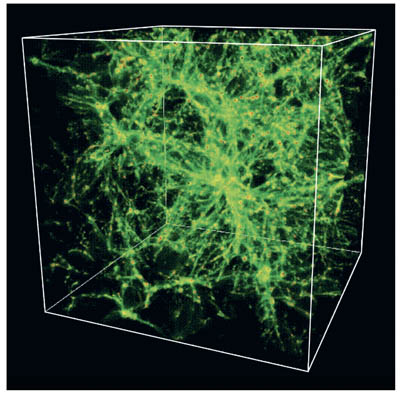 |
Goddard Space
Flight Center NASA > GSFC > Astrophysics Science Division > IXO |
|
Missing BaryonsWhere are the missing baryons and do they form a cosmic web in the nearby Universe? Less than 10% of the baryons in the local Universe lie in galaxies as stars or cold gas. The remainder are predicted to exist as a dilute gaseous filamentary network called the cosmic web. Some of this cosmic web is detected in Lyα and OVI absorption lines, but half still remains unseen. Growth of structure simulations predict that these "missing" baryons are shock heated up to temperatures of 107 K in unvirialized cosmic filaments and chemically enriched by galactic superwinds. IXO is required to enable detection of the missing baryons and characterize their velocity distribution along at least 30 lines of sight. 
The density distribution of baryons at low redshift from the simulation of Cen & Ostriker (2006). Most of the mass of the WHIM lies within the filaments that connect the higher density regions. Click the image for a larger view. Despite local success in finding hot gas in the halo of the Milky Way, observations with the grating spectrometers on XMM-Newton and Chandra have not yielded conclusive proof for the existence of the hot cosmic web at z > 0. The order of magnitude increase in collecting area and R = 3000 spectral resolution of IXO is required to enable detection of the missing baryons and characterize their velocity distribution along at least 30 lines of sight, see Requirements. This distribution of mass as a function of temperature can be determined from X-ray absorption line grating spectroscopy of highly ionized C, N, and O detected against background AGNs. The extent and nature of galactic superwinds that enrich the web will also be measured both from the proximity of absorption sites to galaxies and the dynamics of the hot gas. Most galaxies, in fact, have lost more than 2/3 of their baryons, relative to the cosmological ratio of baryons to dark matter. These missing baryons are probably hot, but we do not know if they were expelled as part of a starburst-phase galactic wind, or pre-heated so that they simply never coalesced. X-ray absorption line observations with IXO will, for the first time, identify the location and metallicity of these Local Group baryons from the line centroids and equivalent widths of hot C, N, and O ions, revealing a crucial aspect of galaxy formation. For more information, refer to IXO Astro 2010 Decadal White Papers:
|